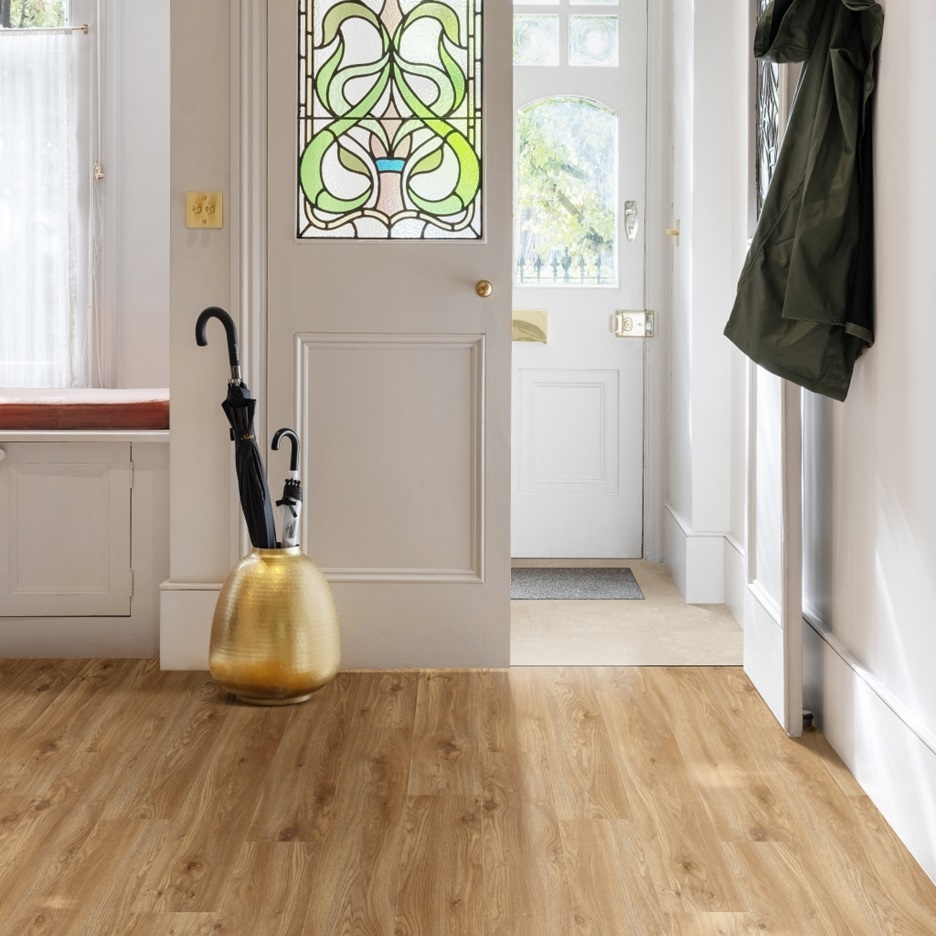11 January 2024
Which flooring is best for your hallway

One of the busiest areas of your home, the hallway can take a beating. Combine that with being the first room you meet from the outside, and you may find your flooring or carpet looking tired quickly. Which ever floor covering you choose, there are suitable options to best suit your hallway.
Things to consider…
Size
The size of your hallway can determine how much traffic your flooring will receive. The smaller the surface area the higher the amount of traffic. This can result in your flooring showing signs of wear and tear, more quickly.
Installation extras
Whether you are planning to install yourself or employ a floor fitter, there are additional costs to consider. The hallway connects many rooms, which can mean the installation is more fiddley and time consuming than a square room with one door way. For floor coverings that require an expansion gap (laminate, Wood, Click LVT) there will be additional accessories required; such as beading (scotia). If you would rather avoid this, you can chose to pay a little extra to remove and refit the skirting boards. Unless you have the same flooring through all rooms, each door way will need a door trim to bridge the gap between rooms.
Flooring levels between rooms
Flooring and carpets come in all shapes and sizes. Having different floor coverings in each room, will create individuality in each space but may also result in different flooring levels. There are different accessories available to help bridge the gap but ultimately you will need ramp profiles to smooth over the different levels. Checking the depth of your floor covering before installation will help to ensure your floor levels match. Remember to include underlays, and any additional subfloor when considering the depth of your flooring.
Is your front door leading directly outside?
Direct contact with the outside can increase the chance of moisture. Choosing a flooring with water resistance or waterproof properties, will help to ensure your flooring looks newer for longer. If you are wanting to chose a wood flooring or carpet for your hallway, introducing a door mat will help to minimise debris and moisture on to your chosen floor covering.
Cleaning
High traffic areas, especially ones that lead outside are susceptible to increased dirt and debris. Being able to clean your floor covering effectively is a must. Adding a door mat to the entrance of your home, will help to reduce dirt.
Carpet
Choosing a two coloured yarn (speckled) or textured (loop pile/flatweave/patterned) carpet, will help to minimise the appearance of dirt and debris. Lighter colour carpets will ultimately show up dirt more readily than darker colours. This style of carpet will also help to disguise pile flattening and shading. When it comes to cleaning man made fibre carpets such as polypropylene, are often referred to as ‘easy clean’ or bleach cleanable. This is because, as you might guess, this material can be cleaned with diluted bleach.
If you are planning on choosing a carpet it’s important to consider the length of the fibres. The longer the fibres the quicker the carpet will flatten and change in appearance.
While wool twist carpets have a great lifespan for wear and appearance, they are not bleach cleanable. That being said, it is possible to clean a wool twist carpet with an appropriate cleaner.
Flooring
A popular choice for hallways. Many flooring options are easy to clean and because dirt and dust sits on the surface, cleaning is more effective.
LVT
Laminate
The most cost effective and easy to install, laminate is a popular choice for experienced DIY’ers. Laminate is made up from layers.
The bottom layer is protective, stopping moisture from penetrating your floor. You then have the core layer, usually made from high-density fibreboard (HDF). Next comes the decorative layer that gives your laminate the look of natural wood. Finally, the wear layer protects your floor from scuffs and scratches. Standard laminate thickness ranges from 8mm to 12mm.
There are many manufactures producing products that have water resistance or ‘aqua protect.’ This will ultimately help to protect your laminate flooring from moisture. Laminate is easy to clean/ wipe and hard wearing. It is worth noting that water resistance doesn’t mean water proof. The surface will be protected from moisture but in the event of a leak a laminate flooring will swell and fail.
Wood
Sustainable, eco-friendly and hard wearing; wood flooring continues to be an incredibly popular choice. Without surface protection wood is susceptible to damage from moisture. Provided the flooring is completely protected with a lacquer or oiled finish, wood is easy to keep clean, maintain and is incredibly hard wearing.
An oiled finish will require a little more attention than a lacquered flooring. It is advised to apply oil to replenish and protect. Using a cleaner specifically for wood floors will help to ensure your floor is maintained and protected correctly.
Brushed (textured) wood will help to minimise the appearance of wear and tear. As will choosing a warmer colour. As with most floor coverings, plainer, lighter designs will show up dirt and debris more readily.

